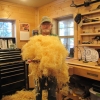In this lesson we'll glue up our starting block of wood. You'll see the fairly strenuous process in some detail, starting with a discussion of the wood and including the important 'dry run'.
When it happens, you'll see that the actual glue up is quite an intense operation and the size of what will be a big block of wood makes it quite hard work - a shame my helper was behind the camera!
It always gives me pause for thought how wasteful is carving and other 'glyptic' work. More of this lovely wood will end on the floor than will remain in the finished shirt. But then, that's probably the same with all woodworking: think of a chair; then think of a tree...

| 15 May 2015 11:03
Ann - If you mean timber that has been 'machined', ie planed with flat faces or edges for the joints, then you should just be able to glue the pieces together without further preparation. Wood glue has no space-filling properies so does need a close fit and the planing machines will achieve this. The other important thing is to make sure you have enough clamps for even pressure and 'squeeze out' all over.

| 13 May 2015 13:35
With two pieces of wood that have been prepared as "lumber" for wood work and scupturing but have not been really finished, does one need to do a special sanding process in order to be sure that the joints are going to really adhere to each other and touch completely?

| 14 September 2014 14:36
Air dried or kiln dried? The real decision has to be where the finished project will be. I've been designing and making furniture for over fifty years and this is fundamentally THE question. When in Uk I would be lucky to obtain air dry timber below 15-20% EMC Here in South West France I easily manage 12% sometimes less. It's central heating that causes the real trouble. All I can say is with a 3" slab at that width I'd be really careful about the EMC of the final hanging place. However, not too many mills will kiln a slab that thick anyhow.
How much easier were the days of Chippendale. He knew full well that the EMC of the Grand houses his stuff went into would be virtually the same as his workshop.

| 25 November 2013 07:50
William - If possible, I always work with air-died wood (as here). It's milder; kilning seems to make wood fibres harder and more brittle.

| 06 November 2013 14:29
Eric - I always go for matching the colour and grain pattern; I'm not too bothered about fibres running against each other along the joints. Why? Any difficult grain, here or elsewhere, I deal with by cutting across the grain with a slicing cut. See Techniques > Cutting to the Chase > # 1 and 2. Wow - one less thing to worry about!

| 06 November 2013 04:53
Chris, I have glued up some walnut for another project and the first thing I had to ponder was "what is the best strategy for matching grain, etc.?" So do you have any thoughts? I tried to find pieces that had similar grain running in the same directions so that when I used a chisel, I would not run into apposing grains at the seams. Am I on the right track? It seems like the carver has a different need than the furniture maker who is alternating cupped grain to prevent warping.

| 27 September 2013 01:28
Love this projet, it gives me some ideas. Thanks

| 20 September 2013 02:12
What a beginning to an incredible project! I'm very impressed. Thank you!